A balanced diet pyramid is a pictorial representation of all the food items a person requires daily. The food items are arranged in ascending order according to their quantity of intake. The food to be eaten in a heavier quantity is placed at the bottom of the pyramid (broad base), and food items that are eaten in the least amount are present at the top of the pyramid (narrow top).
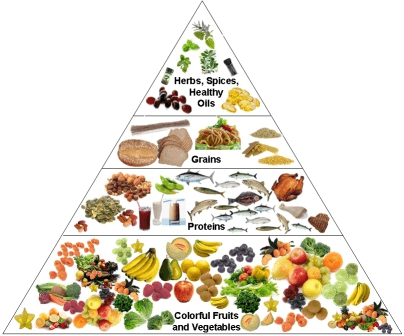
Tools for Meal Planning
Nutrition teaching tools in various formats have been used in many clinical nutrition settings. Guidelines, menu approaches, counting procedures, and exchange systems are some of the examples.
The Food Guide Pyramid
This tool provides basic information to assist individuals in making healthy food choices. They may offer some information on serving sizes and food preparation, but they lack the precision of nutritional data that other approaches provide. If accuracy in nutrient consumption is not necessary, these guidelines are the best tool for nutritional teaching. They may provide enough information for certain people to make dietary adjustments that minimize health risks and enhance clinical markers.
Menus Approach
Menus are a tool for giving customers detailed instructions on what to eat, such as the type of food, cooking technique, and portion size. The popularity of this technique may be seen in the number of patients who meticulously gather their tray menus during their hospital stay. In order to take into account the patient’s culinary preferences and dislikes, most menu planning programs rely on input from the patient. Several days of meals can be designed for survival instruction, utilizing familiar items to maintain proper nutrition.
Menu planning may be utilized at both the practical and continuing education levels and can be coupled with various teaching modalities. Menus may now be planned using computer systems that consider nutritional prescriptions and personal food preferences.
Counting Systems
These systems have been more popular in recent years. Calorie counting is a well-known weight-loss strategy. Fat gram counting is used in instructional materials for cholesterol reduction, cancer prevention, and weight control. Carbohydrate counting, once thought to be a tool for strict insulin therapy, is now being used for the initial and ongoing spread of diabetes awareness in all forms.
Exchange Programs/ Systems
These focus on food categories rather than particular items to teach nutrition concepts. The Exchange Lists for Meal Planning, which have been used for decades to train diabetic patients, are a popular example. Patients can use the system to choose a diet that fits a macronutrient prescription. The notion of exchange lists has been adopted for weight control education, and it is often used to offer nutrient information with recipes and packaged food products.
Plate Model
The plate model is the standard teaching model used in Europe and is used by the Diabetes Atherosclerosis Intervention Study (DIAS). According to this method, the plate is divided into three portions based on visual aid.
One portion consists of half of the plate, and the other two portions cover one-quarter of the plate. According to the recommendations, vegetables, such as salads, are placed in one-half of the plate area; grains in the one-quarter plate section; and meat and alternatives in the other quarter plate section. As side dish servings, other food groups are offered.
DIAS has set nutrient intake targets for study participants, which are monitored using annual 24-hour recalls. The Plate Model and more quantitative exchange lists have been utilized to assist DIAS participants in achieving the study’s objectives.
Many distinctive learner characteristics can be met using adaptations of the above methods for nutrition instruction. The most common tools for initial nutritional education are available in very simple versions, which are easily understandable by low-literacy clients. There are versions translated into Spanish that are also available. The products come under the category of “copy master”. According to this, the material can be photocopied without any issue of copyright infringement. This update for client education is the recent trend in nutrition education resources. Purchasing reproducible resources allows nutrition counselors to quickly access various teaching materials to match the needs of individual clients. The rising alternative of computer software that provides nutrition instruction tools is even more exciting. Computer programs enable the provider to personalize materials to individual patients’ needs and update content as needed. With the recent technological advancement, the purpose of understanding how man interacts with food has become easier. It leads to accurate behavior and an attitude in line with modalities that define human development and evolution.
Balanced Diet
A balanced diet is the combination of all the food items containing a definitive proportion of the necessary nutrients required by the body.
For proper growth and functioning, a combination of four basic elements in appropriate amounts is necessary and enough. The type and amount of food an individual needs depend on the person’s age, health, gender, physical activity, and physiological state.
The four basic elements required in a proper diet are carbohydrates, proteins, fats, and vitamins.
Carbohydrates provide around 50 to 60 percent of total calories. A balanced diet should contain 15 percent proteins and 30 percent fats. A healthy, balanced diet requires the right proportion of food items containing all these elements.
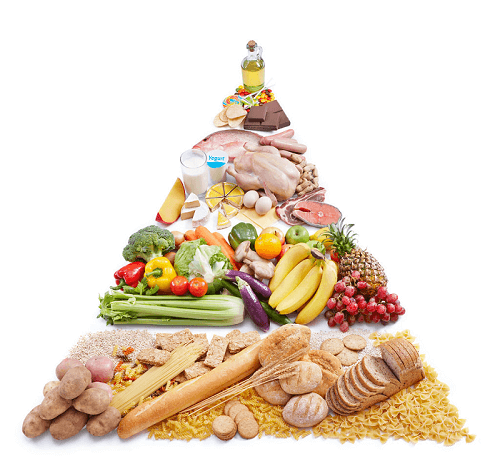
Apart from the four basic components of elements, there are other classes of elements that are required by the body for growth and maintenance. These other compounds are bioactive phytochemicals, nutraceuticals, antioxidants, and dietary fibers. These compounds serve the purpose of additionally protecting the body from foreign agents. The amount or quantity of each element should be taken more or less, similar to the said amount only. Excess of any of the elements in the diet can be toxic or dangerous to health.
Balanced Diet Pyramid/Food Pyramid
A balanced diet is one that provides each person with a definite amount of nutrients necessary for normal growth and development. But the most advanced illustration to determine the correct ratio of food necessary to consume can only be determined by a proper food pyramid. It’s a pyramid divided into “layers,” each of which corresponds to a food group and its accompanying quantity.
The Food Pyramid is a diagram that shows how different foods and beverages contribute to a healthy, well-balanced diet.
According to the Food Pyramid, individuals can choose foods and drinks from each tier based on their food preferences. It divides meals and beverages into five primary shelves, starting at the bottom with the most significant tier.
Tier or Steps of the Food Pyramid
- The first step of the food pyramid includes vegetables, fruits, and salads. The quantity should be at least 5 to 7 servings a day. Enjoy the colorful rainbow made of fruits and vegetables as the foundation for food for the day. It’s always preferable to have more fruits at the start of the day. Limit yourself to one glass of unsweetened fruit juice per day.
- The second step of the food pyramid is to add wholegrain cereals and bread, potatoes, pasta, and rice during breakfast. The best cereals are whole meal and wholegrain. It should be around 3-5 servings per day, up to 7 for adolescent boys and men aged 19-50. Take pleasure in each meal.
- The third step of the food pyramid consists of milk, yogurt, and cheese. The quantity should be 3 servings a day and 5 from the age of 9 to 18. To cut fat from your meal, choose low-fat or reduced-fat varieties. Low-fat milk and yogurt are better choices than cheese. Cheese should be consumed in moderation.
- The fourth step of the food pyramid– under this category come meat, poultry, fish, eggs, beans, and nuts. The estimate is around 2 servings a day. You can choose lean beef, skinless poultry, and fish. Try to add fish to your diet two times a week. Other better options for this step are eggs, beans, and almonds. Try to avoid salty processed meats like sausages, bacon, and ham as much as possible.
- The fifth step of the food pyramid comprises fats, spreads, and oils. To be taken only in trace concentrations, as little as possible is used. Mono or polyunsaturated fats, which are reduced or very light spread, are ideal for eating. The other good options include rapeseed, olive, canola, sunflower, or corn oils. Mayonnaise, cole slaw, and salad dressings are high in oil and should be avoided. While grilling, oven baking, steaming, boiling, or stir-frying, try to use as little oil or butter as possible.
- The final or the topmost step of the food pyramid– This step is separated from the rest of the pyramid. Foods and beverages heavy in fat, sugar, and salt are found on the top shelf. These aren’t necessary for optimal health, and they shouldn’t be consumed on a daily basis. It is sufficient to consume very small amounts at most once or twice a week.
All vital elements must be present at sufficient levels in our diet. We require a well-balanced diet that includes all of the essential elements throughout our lives. The nutrients must be acquired by carefully selecting and mixing meals from various dietary categories. These nutrients are required for physiological and biochemical processes that allow the human body to obtain, absorb, and use food to sustain health and activity.
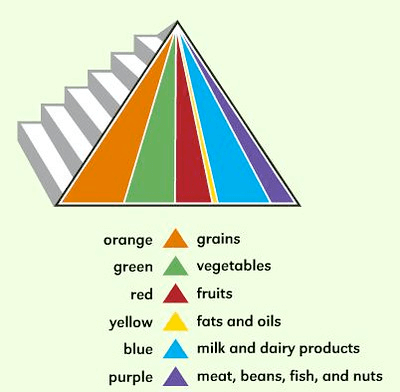
A perfect and balanced diet is required for a healthy body and fresh mind. The food pyramid does this work. It specifies how much a person requires a particular food to maintain a healthy lifestyle. It also depicts different kinds of food and drinks that can be consumed for proper health. It’s separated into six shelves, each of which delivers a variety of nutrients and energy for optimal health. It’s all about picking the proper proportions from each shelf when it comes to eating healthy.
Following the Food Pyramid does not imply that you must attain balance at every meal, but rather that you should strive for it throughout the day and week. To assist you in incorporating the Food Pyramid into your daily life, many countries have prepared food plans and recommendations based on the pyramid! Small adjustments can have a significant impact.
MyPyramid and the USDA Food Guide Pyramid
The USDA established the Food Guide Pyramid in 1992 as a well-known nutritional aid. It is called a food pyramid because a particular pyramid shape is a triangular shape chosen to depict the idea of the quantity of food that an individual should consume. People following the food pyramid would know that the items at the bottom should be consumed more than the food items at the topmost tier.
The food guide pyramid, ascended in horizontal layers, clearly shows the proportionality of food quantity with respect to other food items present at other tiers. There are five major groups of foods and beverages categorized in the food pyramid:
- Rice, bread, pasta, and cereals
- Fruits and vegetables
- All dairy products.
- Meat, poultry, eggs, legumes, and meat.
- Fats, sugars, and alcohol
The USDA released MyPyramid, an updated version of the Food Guide Pyramid, in 2005. Food groups were represented by ascending vertical bars, emphasizing the proper quantities of each food group. They have used an illustration of a man walking up the pyramid using stairs for climbing. They have not used portions to define quantity. Instead, they have used ounces and cups for measurement.
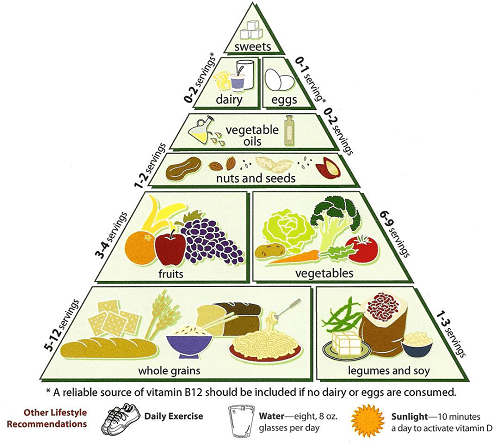
Each ethnic food guide pyramid modifies the USDA Food Guide Pyramid by adding, removing, or substituting culturally appropriate items. Other food pyramids, such as the Mediterranean and Asian, come next. Since dairy sensitivity to cow’s milk is common in this part of the world, yogurt and goat milk products were included in the Mediterranean Food Guide Pyramid. Similarly, soy products were added to the Asian Food Guide Pyramid to substitute nutrients that are generally found in dairy products.
Different people have different nutrient requirements according to their health, age, and lifestyle. Age is a bit of a criterion according to which different pyramids have been created. They are developed to accommodate the different nutrient requirements required by different age groups, like toddlers, infants, and the elderly and very old people. Apart from this, vegetarians, vegans, and non-vegetarians also have different food pyramids according to their unique needs. Despite having many advantages of MyPlate, the USDA introduced the nutrition guide in 2011, replacing the food guide pyramid.
The Pyramid of the Asian Food Guide
Oldways Preservation & Exchange Trust produced the Asian Food Guide Pyramid in 2000. It lists foods and beverages similar to the traditional Asian diet to promote excellent health and longevity.
The food that should be taken in heavier quantities is present at the bottom of the pyramid, and the food items that should be taken in small amounts or for lighter consumption are present at the top of the pyramid. The shape is designed like a pyramid to indicate the definitive amount of the meal and beverage proportion.
In 2010, the MyPlate of the USDA replaced the Asian Food Guide pyramid. Nevertheless, it strongly emphasizes the foods that form the cornerstone of a healthy Asian diet.
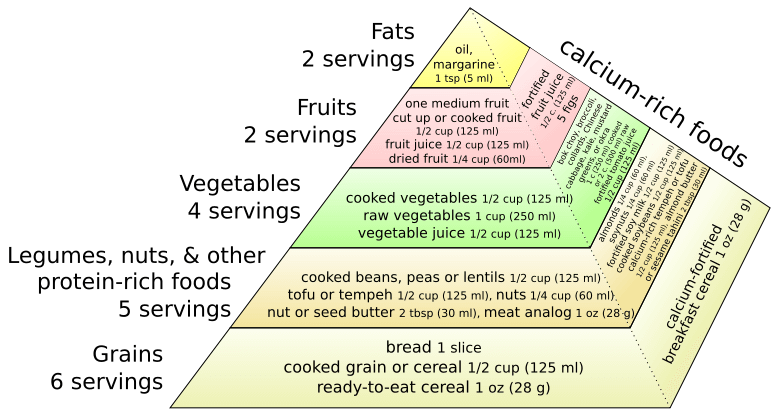
Layers of the Asian Food Pyramid
- The primary focus of the Asian food pyramid was based on a low-fat Asian diet along with a heavy emphasis on vegetables and a strong foundation on daily physical exercise. This makes up the first layer of the Asian food pyramid.
- This layer is followed by another layer, the second tier of the pyramid, which is made up of noodles, rice bread, wholegrain, millet, and corn.
- This layer is followed by considerable layers of fruits, nuts, vegetables, legumes, and seeds.
- After this layer, there is a layer of egg meat, fish, poultry, and sweets. All these food items form a somewhat equal tire, with beef at the top of the tier.
According to this food pyramid, the daily recommendation includes servings of fruits, nuts, vegetables like your seed, and vegetable oil, along with fish as a good alternative. Eggs, poultry, and fish should be eaten once a week, while meat should be eaten once a month. Daily consumption of eight glasses of water or tea is recommended, with wine and beer consumed in moderation.
Food Guides for Vegetarians
A proper food pyramid has been developed for people who do not eat meat or nonvegetarian meals. Loma Linda University designed the Food Guide Pyramid. According to this guide, the servings of important food groups are based on the energy needed for both categories of people: vegans and vegetarians. In addition, the General Conference of Seventh-day Adventists created the vegetarian MyPlate, a vegetarian variant of the USDA MyPyramid. The Vegetarian Resource Group also offers a vegan MyPlate.
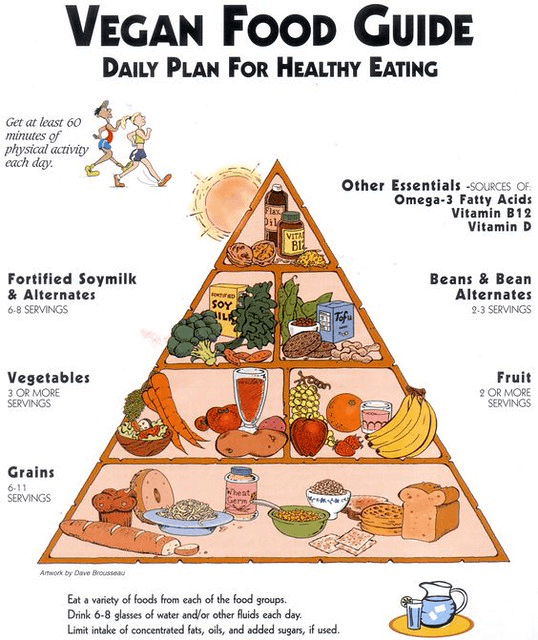
Alternative protein sources, vegetarian recommendations, and the Vegetarian Nutrition Resource List are available on the USDA’s MyPlate website. A Japanese vegetarian eating guide has been produced for the general public and health experts to ensure optimal intake of all nutrients.
MyPyramid for Senior Citizens
Specifically for older people, changes were made to the initial version of the Food Guide Pyramid. The changes are as follows –
- The base of the food pyramid was reduced to reflect a lower energy demand.
- Specific icons and symbols were introduced in the pyramid to demonstrate examples of nutrient-rich food. For example, fruits, green leafy vegetables, and other vegetables are depicted with specific icons.
- Specific food items were included in the new food pyramid that assisted the old people in adjusting to their changing needs and capacities. Food items added include frozen vegetables, low lactose dairy products, frozen fruits, canned low sodium vegetables, and low sugar fruits.
- There also has been an addition of two extra bands to the pyramid’s foundation. These are icons of water glasses to emphasize the significance of proper fluid intake and icons of people exercising to promote the importance of regular physical activity. In terms of food icons, not only are vegetables and fruits with deep-colored interiors that tend to be nutrient-dense emphasized, but also it is emphasized.
- Changes suggest increasing fiber intake: To consume whole vegetables and fruits, rather than juice. Also, to increase fiber intake, whole grain and cereal products contribute to fiber intake rather than refined grain products.
- To reduce saturated fat consumption and promote the consumption of calcium-rich foods: To promote protein-rich foods that are low in saturated fat but high in protein quality to ensure adequate intake. Liquid vegetable oils and soft spreads provide essential unsaturated fats.

